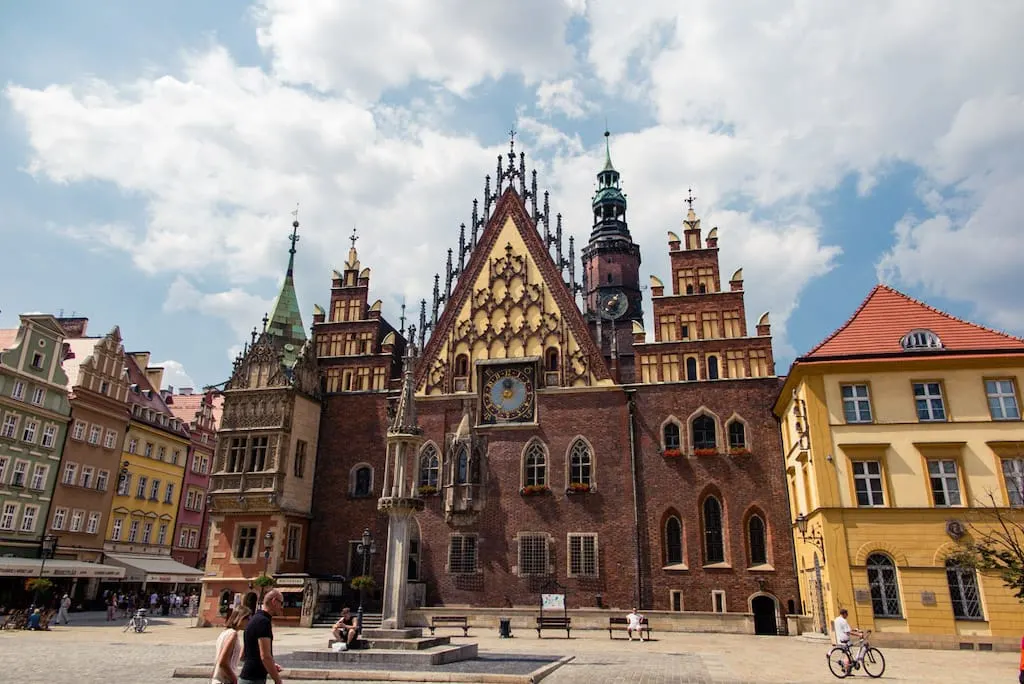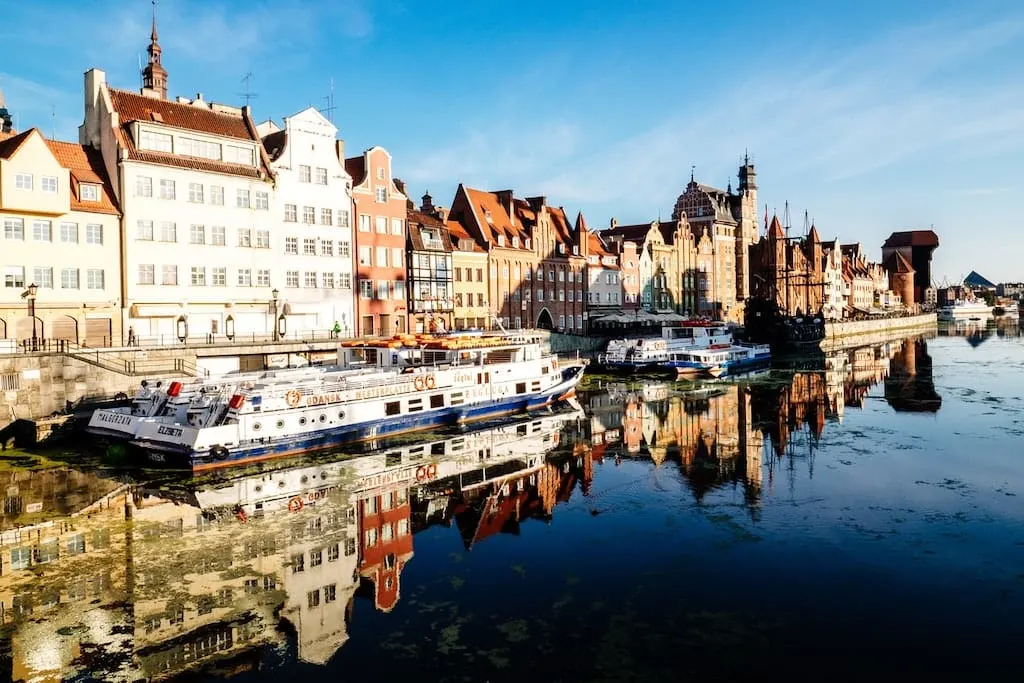Expert travel storyteller Jordan Adkins, founder of InspiredByMaps.com, brings a decade of adventures across 101 countries and 450+ UNESCO sites into rich, off-the-beaten-path narratives, melding ecological expertise with genuine, seasoned travel insights. His full bio can be found here.
Poland is one of the most underrated travel destinations in the world, an intertwined mess of historical and contemporary excitement from the history-soaked streets of Krakow to the wild of Białowieza Forest and storybook-esque Lancut Castle.
There’s so much to see here but exploring Poland’s most iconic landmarks is a perfect place to start …
There are beautiful cities, architectural landmarks, touching tales, small towns, stately homes, parks, farms, art and design, exhibitions, and lots of customs and rituals. As you would expect in a proud nation with a long and storied history.
It is possible to forget in the middle of all this, that Poland also has some beautiful scenery with rolling hills, low mountains, and more than a few national parks to explore.
In this Central European country, there’s just so much to visit; you might spend a lifetime enjoying its wealth and only just begin to scratch the surface. That’s why we created this cheat sheet to support you on your journeys.
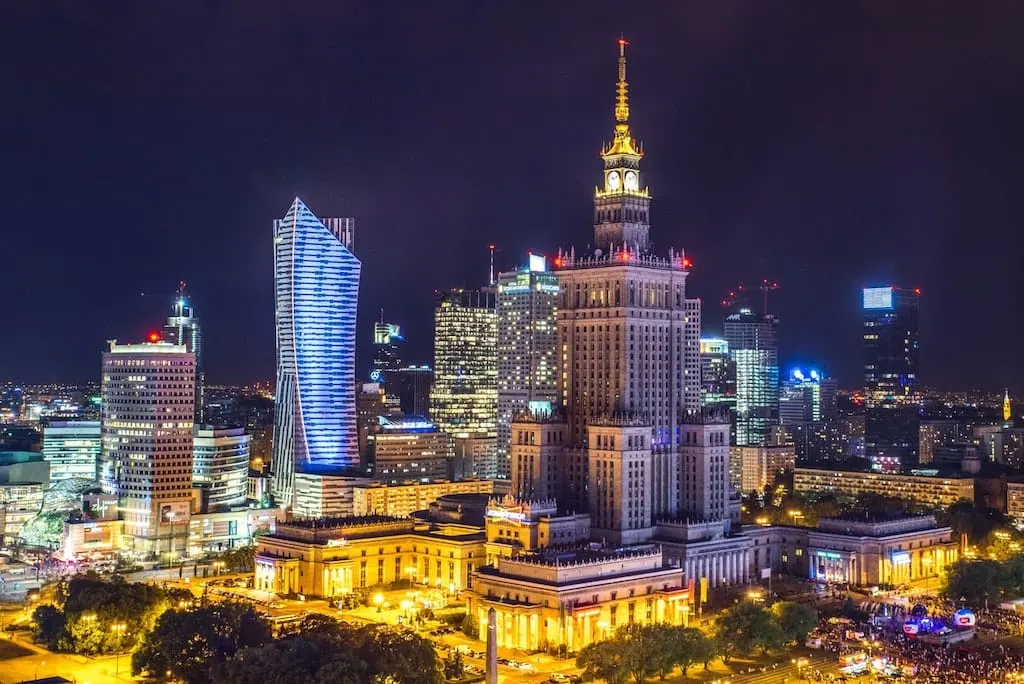
But first – what is a landmark?
A landmark is a distinctive natural or artificial attribute that usually stands out from its surroundings and has become an emblem of local or national character. A landmark is helpful for urban visitors, both in terms of being a tangible waypoint and in trying to assist you to coordinate your itinerary.
Getting off the beaten track is all well and good, but at the end of the day, there are some places you just need to see when you visit a country. Immediately recognizable places that you couldn’t miss if you tried – like the Acropolis of Athens in Greece or Disney World in Florida. And Poland has more than just its fair share …
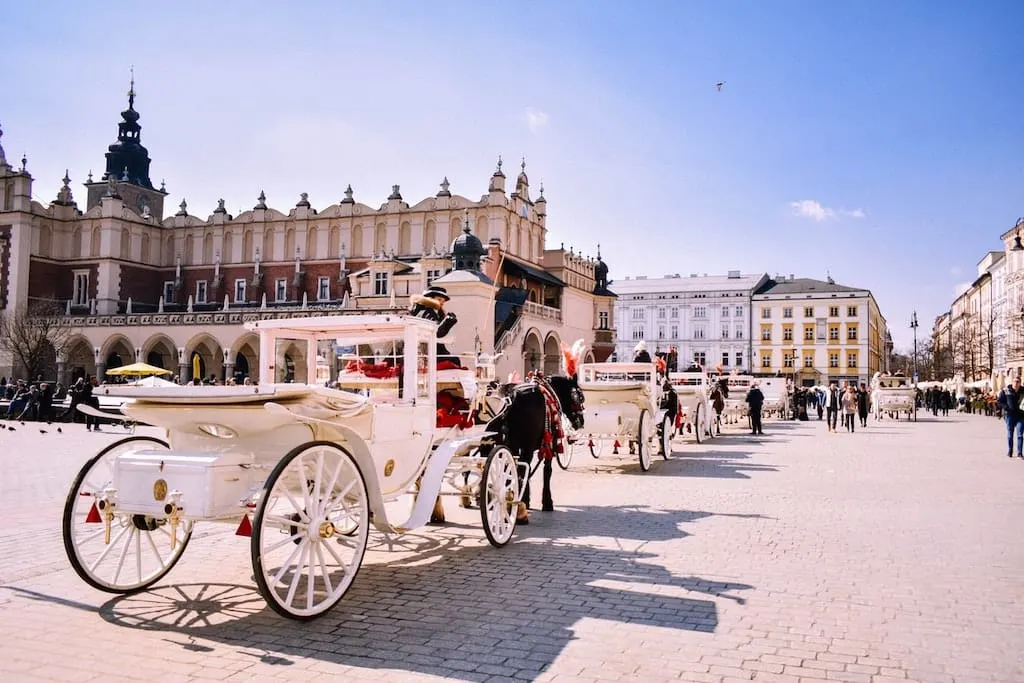
When approaching a trip to the land of pierogi and potatoes, you will want to tick off as many famous Polish landmarks as you can – and the best way is to do that is often by renting a car, taking a tour, or using the Eurail Pass to get around.
There is a lot to explore in Poland — and no list of famous Polish landmarks can ever be exhaustive. But, we’ve tried to get the best bits by calling out to our favorite travel bloggers and asking them to give us tales and helpful tips about their best-loved ones.
This way, you have an appropriate frame of reference to motivate your journeys to Poland, from which you can select a few landmarks that you truly can not miss … Or shoehorn as many of them as feasible on a single trip.
If you plan your Polish trip right — and you’ve got enough time — you could just hit them all. And discover a great deal more of your own highlights of Poland while you’re at it!

Page Contents
- Auschwitz-Birkenau Concentration Camp
- Białowieza Forest
- Centennial Hall
- Fryderyk Chopin Museum
- Historic Centre of Warsaw
- Kazimierz
- Kraków Cloth Hall
- Lancut Castle
- Malbork Castle
- Morskie Oko Near Zakopane
- National Stadium In Warsaw
- Neptune’s Fountain, Gdansk
- Oskar Schindler’s Factory
- Palace Of Science And Culture
- Poznań Fara
- St. Mary’s Church In Gdańsk
- The Village Of Żuraw
- Wawel Castle
- Wieliczka Salt Mine
- Wrocław Town Hall
Auschwitz-Birkenau Concentration Camp
One of the most infamous locations in Poland was built by Germans in World War II and became a symbol of one of humankind’s darkest moments. It is more commonly known by its German name: Auschwitz-Birkenau. A Nazi concentration camp and an extermination camp, nearly 1.1 million people perished here in a little over five years, the majority of them Jews. Other victims included Romani, homosexuals, clergymen, and prisoners of war.
Today, the camp, which is near the town of Oswiecim, has been preserved as a reminder of the horrors of war. Many express bus services to the site run from Krakow’s main bus station, and the ride takes 1.5 hours. Entry is free, while the cost of joining a guided tour with a museum staff varies. The infamous ‘Arbeit Macht Frei’ gate greets everyone who enters the Auschwitz camp, and it portends a very sobering experience.
Visitors come face-to-face with piles of shoes, spectacle frames, and hair in one of the exhibits; they once belonged to people who were killed on arrival. Being in the same spaces where people were beaten, gassed, hanged, and shot just because of who they were leaves no-one unmoved. There is also a second camp, Auschwitz II, three kilometers away. One can take the shuttle bus or walk there to see the gatehouse that features in many photographs.
A visit to Auschwitz-Birkenau easily takes up half a day, but one should be prepared to spend the rest of the day processing what they saw. Given the current political climate, a reminder that we can never let such atrocities happen again is even more important.
Explored by Nicholas from Rambling Feet
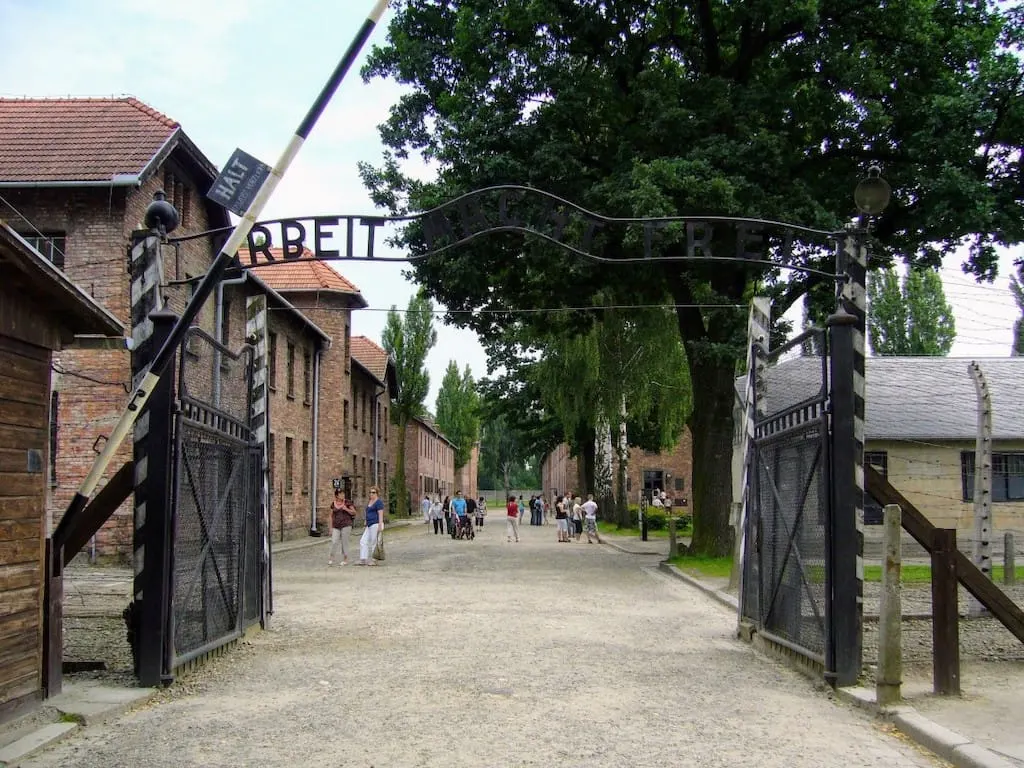
Białowieza Forest
The Białowieża Forest is a vast forest complex that straddles the border of Poland and Belarus and consists of the relics of several primeval forests: Białowieża Forest, Ladzka Forest, Świsłocka Forest, and Szereszewska Forest.
It is considered a natural landmark of Poland as it protects one of the last and most extensive remaining parts of the primeval forest and ancient woodlands that once expanded across the European Plain. The forest is home to 800 European bison, Europe’s heaviest land animal, and covers a total area of 141,885 ha – and on the Polish side, most of the Białowieża Forest is protected as the Białowieża National Park. Interestingly, the European Bison was saved from extinction hereafter generations of hunting trips and later poaching by soldiers after WW1.
In 1919, the last European Bison was killed in the wild, but Białowieża brought specimens from zoological gardens around Poland and the region; and originally, they were raised just like cows on a separate field to the forest. In 1952, the first specimens were released back into the wild, and currently, there are approximately 400 European Bison’s in Poland and around 300 specimens in Belarus.
There are still 3000 specimens in the whole world, and every single one of them can now be traced back to the conservation work at Białowieża. The small village of Białowieża is the best place to head to explore this incredible landmark, and from the guesthouses here, you can set out on hikes and bike rides through this natural wonder.
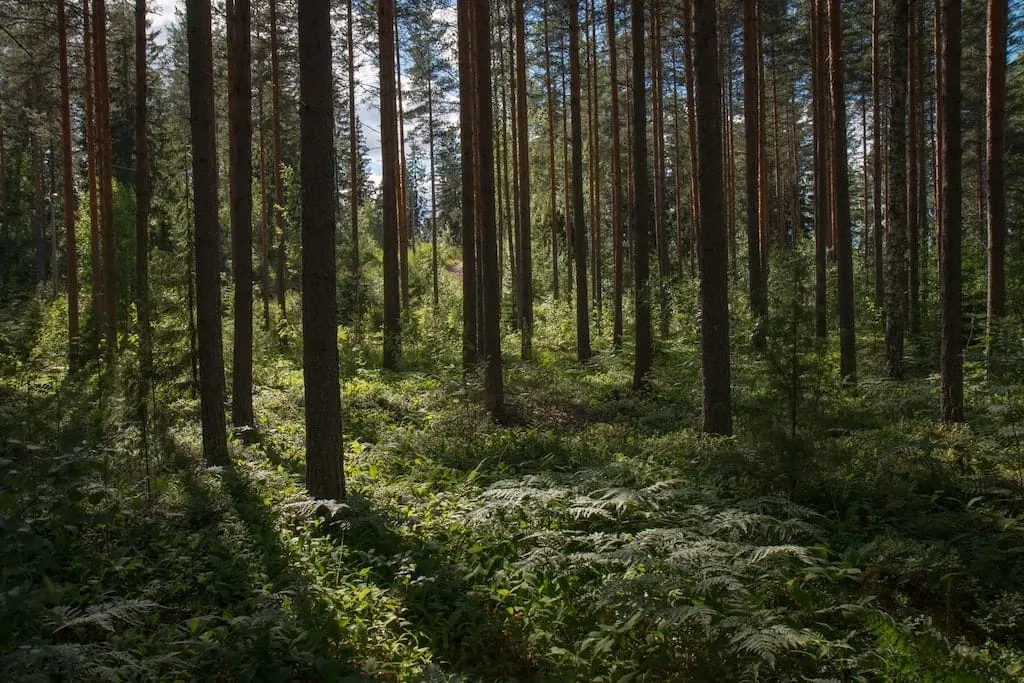
Centennial Hall
The Centennial Hall, previously named Hala Ludowa, is a celebrated building in Wrocław envisioned according to the plans of architect Max Berg between 1911–1913 when the city was within the bounds of the German Empire.
A landmark in the archives of reinforced concrete architecture, the imposing Centennial Hall was erected as a multi-purpose recreational building, and its symmetrical form with a vast circular central space can seat some 6,000 persons. The 23m-high dome is topped off with an incredible lantern made of steel and glass. The Centennial Hall is a pioneering effort of contemporary engineering and architecture and became a key source in the later expansion of reinforced concrete structures.
The Hall is listed as one of Poland’s official national Historical Monuments and continues to be utilized for sporting events and concerts even today, over a century on. For interested visitors, there is a tourist information center open from Thursday to Sunday between 10 am and 6 pm where you can arrange entrance for a small fee – or you can try to organize to see a concert here by looking at upcoming events on their website.

Fryderyk Chopin Museum
The Fryderyk Chopin Museum is a landmark museum in Warsaw founded in 1954 and devoted to celebrating Polish composer Frédéric Chopin. The museum originally had two separate branches – the Birthplace of Frédéric Chopin, at Żelazowa Wola; and Chopin Family Parlor, on Krakowskie Przedmieście, Warsaw. However, the Family Parlor location has since closed with the refurbished of the other location for the 200th anniversary of Frédéric Chopin’s birth in 2010.
Today, the Fryderyk Chopin Museum multimedia museum is one of the most modern museums in Poland and has an incredible collection displayed on five levels of exhibition space across 15 rooms. Expect to find anything and everything to do with the history and works of Chopin, including original manuscripts and documents written by the composer along with photographs and sculptures of him and some of his letters.
There are also piano recitals and competitions of Chopin’s work, not to mention the sumptuously rich stucco and Pompeian style frescoes of the historic building.

Historic Centre of Warsaw
The narrow cobblestone streets of the old city of Warsaw lead you from the Royal Castle at Plac Zamkowy (castle square), through the main market square, to another castle on its other side, the Warsaw Barbican.
While this is one of the main tourist attractions in Warsaw and one of the prettiest areas to stroll on in the city, not many people know that most of the beautiful buildings here are not as old as they seem to be. The old city of Warsaw, like the rest of the city, was destroyed in World War II almost completely, and then rebuilt from scratch based on old pictures and drawings after the war.
Established in the 13th century on the Eastern bank of the Vistula River, Warsaw has not always been the capital of Poland. Only in the 17th century, King Sigmund moved his residence and the parliament of Poland from Krakow to Warsaw, to the Royal Castle. This castle has been standing in the southern entrance of the Old city up until today and in front of it, on a 72-feet-column, stands the statue of King Sigmund, since 1644.
The Barbican, on the other side of the old city, was built in 1540 to protect the entrance of the city. However, in reality, this castle was used only once for military purposes in the battle against the Swedish in 1656. Since the 18th century, it was simply used as the entrance gate to the old city.
The streets of the Old City of Warsaw, which is a UNESCO World Heritage Site, are full of restaurants, cafes, and shops. Walking in these streets and realizing the history of the place makes the experience incredibly unique. Sitting in one of the restaurants of the main market square, between the picturesque buildings and drinking a glass of Polish beer, is the way to have a classic Polish experience.
Explored by Moshe from The Top Ten Traveler
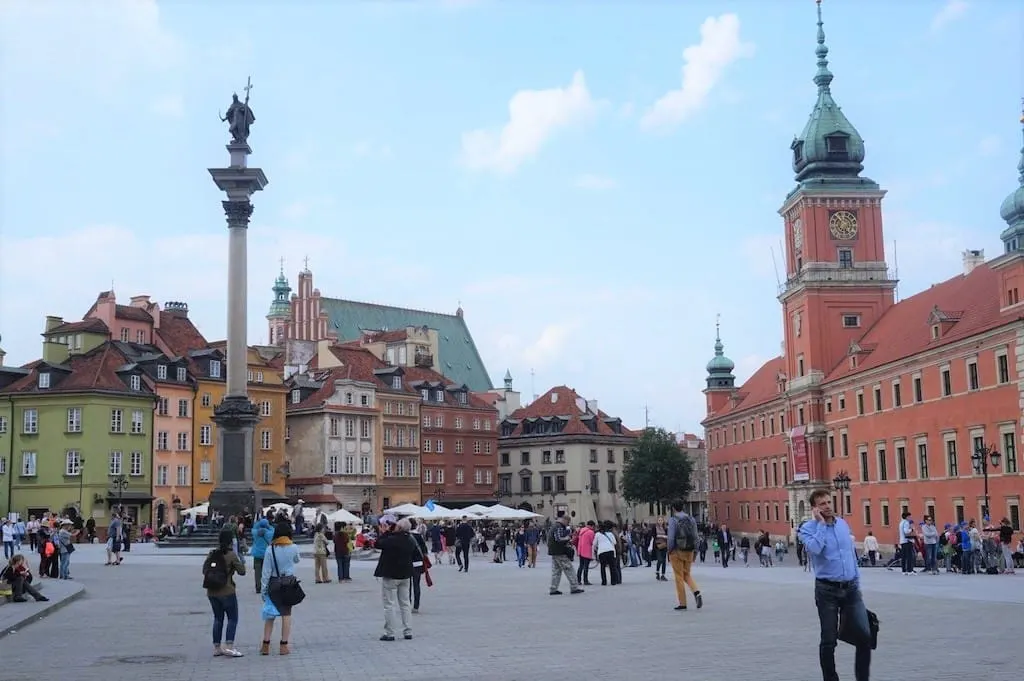
Kazimierz
In 1335, King Casimir the Great, founded a city near Kraków called Kazimierz. At that time, the Jews were allowed to settle around Jozefa Street, which was next door to the Christian Quarter.
The Jewish people built synagogues, schools and bought more land for houses in the area, which became known as the Jewish Quarter. In the 1800s, when Austria annexed Kraków, Kazimierz became part of the city of Kraków. During the Nazi occupation of Poland, the Kraków Jewish area of Kazimierz became the Jewish Ghetto, and most of its inhabitants were murdered or sent to Nazi death camps such as Auschwitz.
Kazimierz is the best-preserved Jewish area in Poland. Among the many memories held within the heart of this area is a series of shops that have been preserved with their signage but today stands as both a restaurant and memorial to Jewish culture within Kazimierz.
Chajim Kohan, also known as Once Upon a Time in Kazimierz, is set inside a row of reconstructed 19th-century Jewish traders’ shops. The restaurant offers Jewish cuisine with a Polish influence, including a Kosher vodka. It contains 11 tables offering an experience in dining like no other.
The walls that are used to separate the buildings have been removed, and the original décor from each shop has remained along with the original restored signs from the shops.
Explored by Faith from XYUandBEYOND
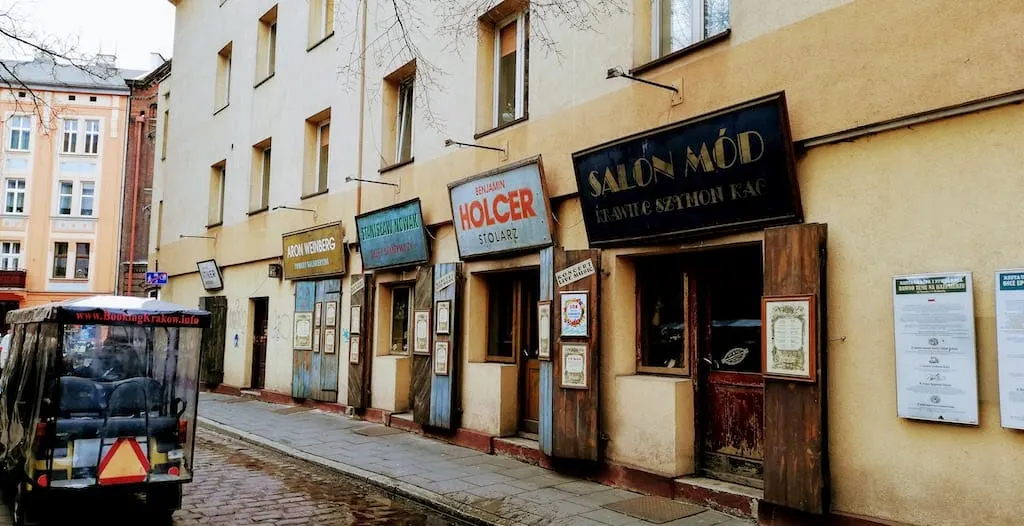
Kraków Cloth Hall
The Cloth Hall, located in the middle of the Main Square, is one of the most impressive Polish landmarks. You cannot imagine the Krakow main square without it. As in the past, this building primarily serves commercial functions, but today, instead of buyers, it is mainly tourists who visit the Sukiennice.
The history of Sukiennice is as old as the history of the Main Square. When the city was founded under Magdeburg law in 1257, prince Bolesław the Chaste also promised to build cloth stalls for the inhabitants.
Sukiennice change its look several times – The first Cloth Hall was made of stone, the next, erected in the middle of the 14th century by Casimir the Great – already made of brick, though it got burnt and rebuilt in the Renaissance style.
In the 1870s, however, there was a need to renovate the building. The renovation works were managed by Tomasz Pryliński and Jan Matejko (famous polish painter). As a result, the cloth hall lost its longitudinal character, and new, beautiful facades appeared on the side of Szewska and Sienna Streets.
From the end of the 19th century, the appearance of the Sukiennice practically did not change. Today, the Cloth Hall is a great tourist attraction. Downstairs there are stalls with handicrafts, jewelry, and souvenirs, while on the first floor is occupied by the Gallery of Polish Painting and Sculpture of the 19th century. You can find here pictures of the famous Polish artist.
While visiting Krakow with kids, Sukiennice is a must to go inside and browse the stalls for original local souvenirs, often toys.
Explored by Ania from The Travelling Twins
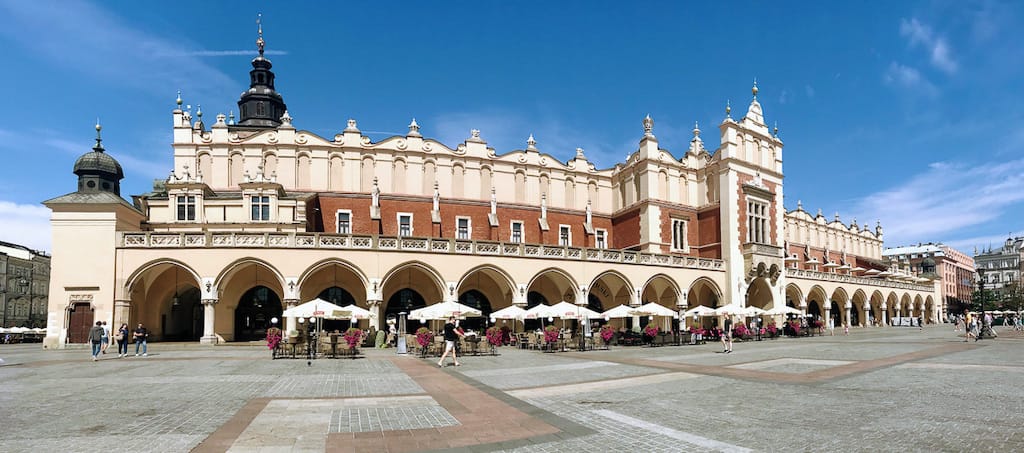
Lancut Castle
As one of the most beautiful palaces in southern Poland, Lancut Castle is among the top things to visit when going to the small town that sits just east of Rzeszow in southeast Poland. Stemming from aristocratic families that purchased land in the city over time, Lancut Castle became a beautiful fortified residence in the small city.
A renowned architect was employed to create a castle that would be safe, secure, and splendid. The castle sits on dozens of sprawling acres with pathways and green space all around. Many of the pathways run through old trees lined up alongside and around the castle.
A pond, tennis courts, flower houses, a guest house, and other small buildings are sprinkled across the estate. The castle itself is a magnificent work of art, even more so when learning about the vast collection of historical art, particularly carriages that are stored in the nearby stables.
The oldest carriage in Poland is housed in one of the stables, as well as dozens of carriages in various styles that were used in the last few centuries. The interior of the palace has a variety of rooms, from sitting rooms to a great ballroom, and each room features furniture and wardrobe from specific eras.
Tours of the inside of the castle occur in both English and Polish, and tickets can be purchased in the museum across from the castle. It is best to get there early as there are typically lines, and tickets are limited to specific times. Summer is especially busy, as are the weekends. Tours occur in two parts, the inside of the castle as well as a tour of the carriage houses which are across the street. It is easiest to get to Lancut on the main highway or the main road from Rzeszow.
Rzeszow has a small airport that services national and international cities, and the drive from the airport to Lancut is only a 20-minute drive.
Explored by Diana from Travels in Poland
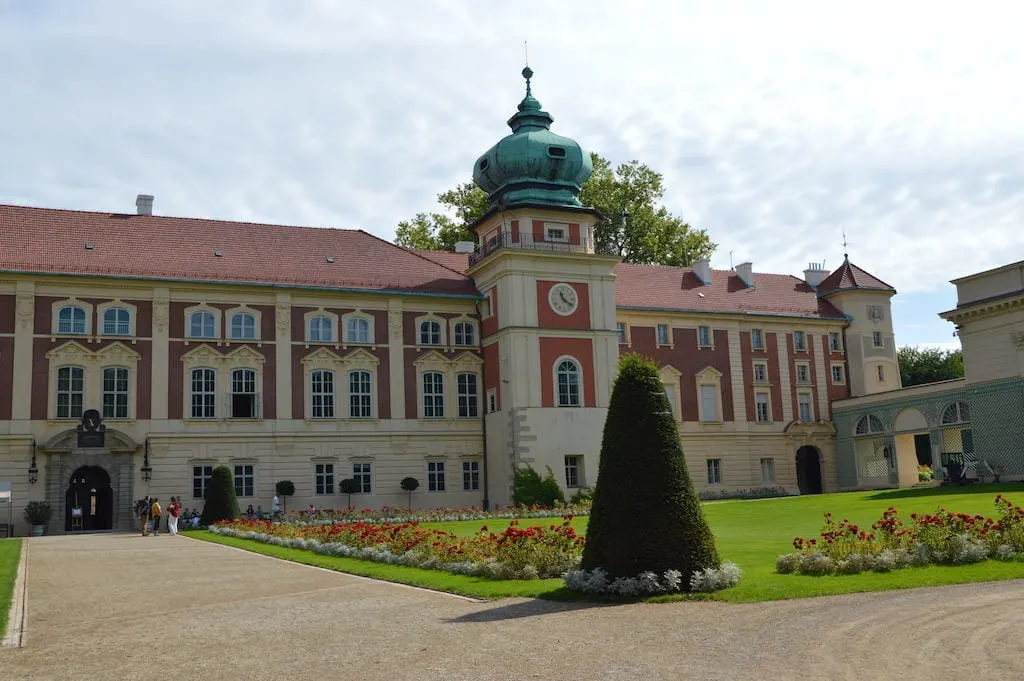
Malbork Castle
Did you know that the largest castle in the world is located in Poland? The Malbork Castle, located in the northern part of the country, near Gdańsk, is one of the most impressive places you can visit in Poland and a UNESCO site.
The works started in the late 13th century, and the castle was built in a few stages. At first, the castle belonged to the Teutonic Order, the German Catholic crusaders who have conquered the area. They called the place “Marienburg”, to honor Mary, the mother of Jesus. Over the centuries, the castle has expanded and changed rulers; it belonged to Polish royalty, then to Germany, and eventually it came back to Poland after World War 2.
Malbork Castle is an exceptional place to visit. The architecture is jaw-dropping, a perfect example of Gothic that will take your breath away when you wander around the castle and its numerous rooms. The castle is divided into three parts, High, Middle, and Lower ones, divided by dry moats and towers. You need at least 2-3 hours to see all the highlights, but you can as well spend the whole day visiting Malbork Castle.
Since this is a popular tourist attraction, visited by thousands of people each day, it’s worth booking the ticket online in advance. Getting to Malbork is very easy, there are frequent trains from Gdańsk or Warsaw, the train station is located some 20 minutes walking from the castle.
After you visit the castle, be sure to go to the other side of the Nogat river to find the best viewpoint and see the castle in full glory.
Explored by Kami from My Wanderlust

Morskie Oko Near Zakopane
Morskie Oko near Zakopane is one of the most famous natural landmarks in Poland. The largest and one of the deepest lakes in the Tatra Mountains, it indeed deserves the name Eye of the Sea, the English translation of Mosrkie Oko.
Located in the Rybi Potok Valley deep within the Tatra National Park, this iconic landmark can be reached by taking a car or bus to the national park and following the red trail by foot.
The trail to Morskie Oko consists of paved roads that make it accessible even for those who are new to hiking. Bear in mind, however, that this will be a 2-hour journey to the lake. The good news is that there are cabin toilets along the way. For those who may be daunted by the long walk up, one can hire horse-drawn carts that cost 40PLN or 10EU per journey.
The journey is worth the sight of the turquoise and green tones of Morskie Oko, which is so clear that one can see the fish through the water. This is probably the reason why this lake was once called Rybie Jeziero, the Lake of the Fish.
The lake’s water also has a mirror-like quality that reflects the peaks of the Tatras on its surface, creating a wonderful landscape. Perhaps it is also due to this reflective quality that caused the lore that one can find a giant fish with a head of a sheep in the waters of the Morskie Oko.
Overlooking the Morskie Oko, you will find a rock with 2 points. They call this the Mnich, which means monk in English. According to local legends, a monk from the Red Monastery created a flying contraption that allowed him to fly to Morskie Oko. Having displeased God for creating something unnatural, he was turned into a rock.
When you pack for your trip to Morskie Oko, make sure to travel light. Pack a waterproof in case of rain and a thermos. Having a hot beverage during your trip can make the cold easier to bear. Make sure to bring some money with you as there is an inn by the lake where you can get some food and possibly some warmth before you begin your journey back to the entrance.
Explored by Karolina from Lazy Travel Blog
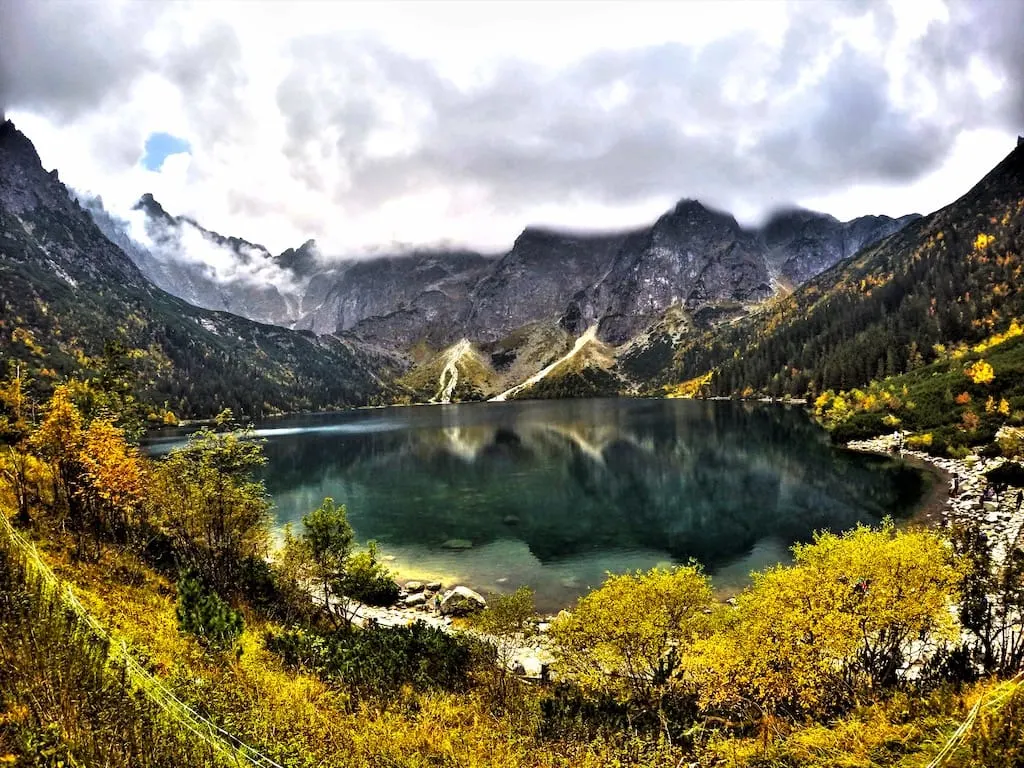
National Stadium In Warsaw
The National Stadium was built in 2008-2011 before the 2012 European Football Championship hosted by Poland and Ukraine. It has the highest category in the UEFA classification and seats 58 580 spectators.
Besides football games, it hosts other sports (in 2014 it was equipped with a huge pool and fans and hosted an indoor windsurfing competition), cultural events like concerts (including Coldplay, Madonna, and Beyonce), and business events (it’s the biggest conference center in Warsaw).
The facade of the building refers to Polish national colors, resembling a waving white and red flag. It’s also beautifully illuminated at night. The stadium has a retractable roof, an underground car park for 1,765 cars, 965 toilets, four restaurants, a fitness club, and even a multi-faith chapel. In winter, the stadium plate turns into a large ice rink open to the public.
The current venue is built on the site of the 10th-Anniversary Stadium (Stadion Dziesięciolecia). Built-in the 50s and opened on the 10th anniversary of the Manifesto of the Polish Committee of National Liberation (hence its name), for years, it was the biggest stadium in Poland. In the 1980s, it fell into decline, and there were not enough funds for its renovation. Consequently, it has become a huge bazaar known as Jarmark Europa, one of the largest in Europe.
According to police data, it was also one of the most important hubs for trafficking in illegal software, weapons, smuggled alcohol, and cigarettes.
It’s amazing that in just a few years, a place like that has become a modern multi-purpose sport and cultural venue.
Explored by Anna from Liquid Traveling

Neptune’s Fountain, Gdansk
Neptune’s Fountain in Gdansk is situated in the center of Dlugi Targ, a place full of old historical buildings. It is situated since 1633 on the Long Market in front of the Artus Court. It has become one of the most recognizable and iconic symbols of Gdansk. The statue is iconic because it was made by a Flemish artist and is one of the oldest monuments in the city. Neptune’s Fountain is a perfect outing spot, as well as a good start to a walking tour in Gdansk.
The bronze statue of the Roman God of the Sea was first created in 1549 before being turned into a fountain. The fountain combines elements of Rococo style and Mannerism. The statue of Neptune is itself inspired by the sculptures of Roman and Greek antiquity.
According to the legend of the fountain, Neptune’s got tired of the people throwing gold coins in his fountain. People did this to pray for financial luck. One day he got furious, and he hit his trident on the ground pulverizing all the gold coins into tiny bits. This is how Gdansk got its Goldwasser, a liquor with tiny gold flakes.
Like the city, the Neptune represents a storied history in itself. The colorful and historic buildings of Dlugi Targ make a great spot for any photoshoots. The statue beautifully fits into its surrounding in the market street. Travelers are charmed by this old statue and the place it is surrounded by. The market street offers picturesque stalls where travelers can also get affordable outdoor gifts.
Visiting the Neptune’s Fountain in the morning can be helpful because of fewer crowds. Taking a seat and admiring the beautiful cityscape in less crowd can make it a positive visit. Travelers can reach there by taking a bus, taxi, or even on foot.
Explored by Paulina from Paulina On The Road
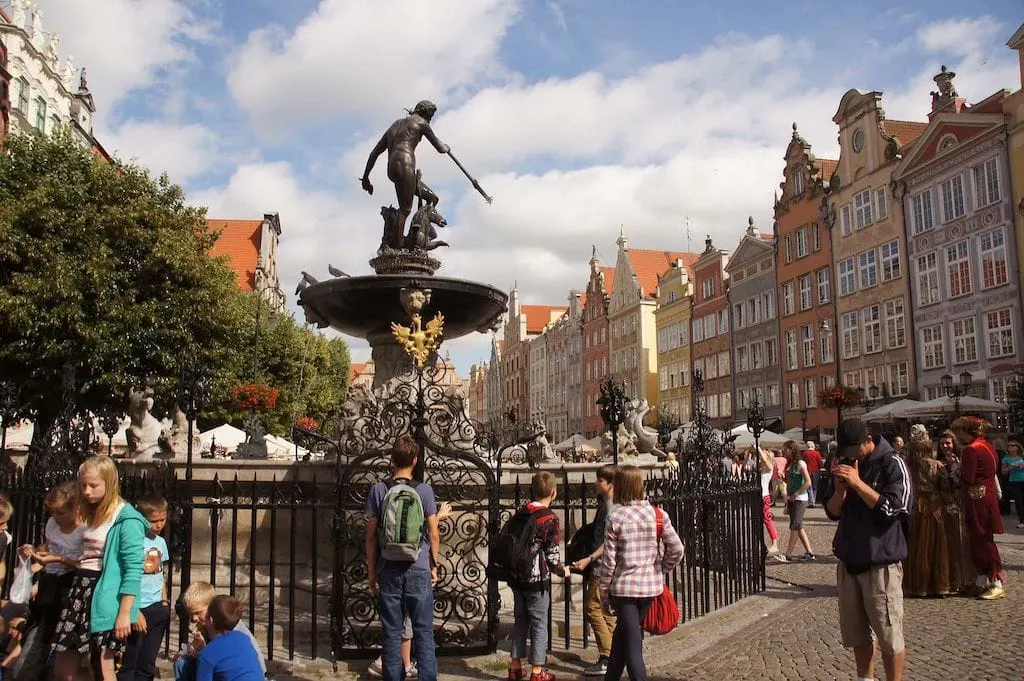
Oskar Schindler’s Factory
Another famous landmark of Poland is there former Oskar Schindler’s Enamel Factory, which now hosts a perpetual exhibition entitled Kraków under Nazi Occupation 1939-1945, and is the most impressive and important presentations to attend when in Krakow.
The Factory was taken over by German industrialist and Nazi Party members Oskar Schindler after the occupation of Poland in WW2- and who is credited with saving the lives of 1,200 Jews during the Holocaust by employing them in his enamelware and ammunitions factories. While the building itself is rather plain, it is the history and showcase here that it is worth attending to consider both the individual and collective dimensions of the monstrosities WW2 brought upon Polish citizens.
The exhibition tells the gruesome history of Krakow during World War II – how citizens were fed Nazi propaganda, how Jews who were required to subsist in a ghetto, and about the victims of the terror of the war. The museum inside is built in a novel way in that each room arranged to match a very particular place – a street, a hairdresser’s salon, a labor camp, a railway station, and many, many more (there are 45 rooms in total).
This museum that just does not get tedious! It is like a history lesson that you can simply walk into – and you’ll walk out with a completely different understanding of the events which took place here.
Explored by Jack from Queer In The World
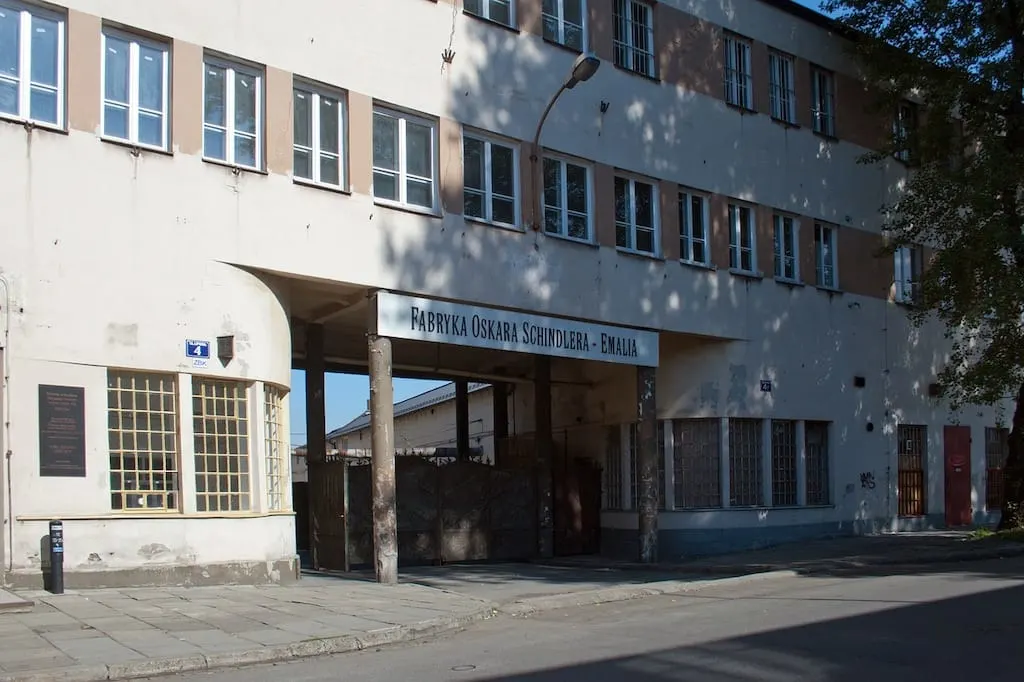
Palace Of Science And Culture
The landmark Palace of Culture and Science is a distinguished high-rise building in the center of Warsaw. With a total height of 237 meters (778 ft), it is the tallest building in Poland and the 5th-tallest building in the European Union.
Erected in 1955, the skyscraper houses various public and cultural institutions such as cinemas, theatres, libraries, sports clubs, university faculties, and authorities of the Polish Academy of Sciences. It is considered a highly controversial building, as even though it has been ‘destalinized,’ it serves for some as a reminder of Soviet influence over the Polish People’s Republic, particularly due to its construction when there were mass violations of human rights under Joseph Stalin.
Today the building is used largely as an exhibition center and office complex, though contains a multiplex cinema with eight screens, four theatres, two interesting museums (Museum of Evolution and Museum of Technology), bookshops, a large swimming pool, an auditorium hall for 3,000 people called Congress Hall, and even an accredited university, Collegium Civitas.
For tourists, head to the terrace on the 30th floor for the ultimate experience and to get a panoramic view of the city.
Explored by Jack from Queer In The World
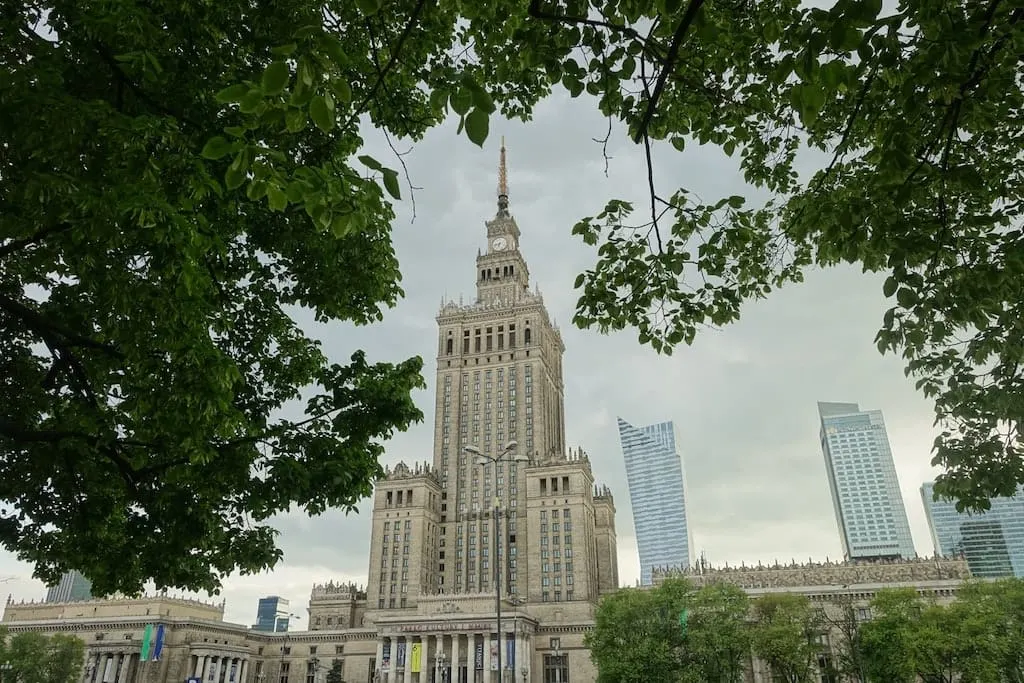
Poznań Fara
Poznan’s Old Town is filled with beautiful, colorful buildings, but one of its unmissable and most recognizable landmarks is the pink Parish Church of St. Stanislaus, also known as Fara.
This stunning Roman Catholic church was built in the 17th century and survived two world wars. Not only is it one of the largest churches in Poland but also one of the most exquisite examples of Baroque architecture in the country. Some of the architectures that have worked on its design throughout the years were Italians, which is one of the reasons for the major aesthetic Roman influence you can see.
The church is, without a doubt, one of the top things to see in Poznan. It’s gorgeous from every angle, but Świętosławska Street is the best spot to marvel at its iconic intricately-detailed main facade. You should also head to the beautiful Courtyard of the City Hall (Wolny Dziedziniec Urzędu Miasta) at 17 Kolegiacki Square for more photogenic angles.
The three-nave interiors of the church are also extremely impressive. With massive marble-like columns, a huge painted dome, old paintings and sculptures dating back to centuries ago, and a 19th-century pipe organ (which has almost 2,600 pipes), it’s impossible not to be in awe. The church also hosts free weekly organ concerts.
Fun fact: A local legend says that a ghost of a woman in black occasionally appears on the organ’s balcony. Supposedly, she is protecting the instrument, which she has donated a lot of money to purchase in the 19th century.
Explored by By Or from My Path In The World

St. Mary’s Church In Gdańsk
Undeniably, Gdańsk is one of the most well-endowed cities when it comes to famous landmarks in Poland. This metropolis is the provincial capital of Pomerania. And among the centuries, it gathered dozens of important spots on the city’s map.
One of the most significant of them is St. Mary’s Church. Officially: Basilica of the Assumption of the Blessed Virgin Mary. This huge temple definitely dominates the Gdańsk panorama. And it couldn’t be different since it’s the third biggest brick church in the world. And that’s the main reason why it’s so important.
The construction of the temple begun in 1343, so the building was the witness of a huge part of the city’s history. Over the years, the Basilica has been home to the Roman Catholic Church, with a period for the Evangelical Church. Today it is a co-cathedral in the Roman Catholic Archdiocese of Gdańsk.
During the II World War, when the Gdańsk was almost totally destroyed by the Nazi army, the Basilica had some luck. It had lost a big part of the roof and heavy bells. But besides this, the build still stayed. During the second half of the 2oth century, it was reconstructed, and some reconstruction works continue until today.
This landmark is one of the most obvious to see for tourists visiting Gdańsk. It’s super easy to find because it’s located in the middle of the Old Town. It’s surrounded by narrow, charming streets with lots of restaurants and cafes.
But before you head to one of these places, you should be sure to visit each corner of the Basilica. And for many people, the most exciting activity to do inside is to climb the monumental bell tower. The walk to the top of it is long, and you’d better have a good condition to climb all of these steps. But the view from the roof is incredible. You are able to see the whole panorama of Gdańsk: the Old Town, the port, the sea, and the green forests surrounding the city.
The St. Mary’s Church is often called “the crown of Gdańsk.” And after visiting it and contemplating its dignity, you’ll understand why.
Explored by Dominika from Sunday In Wonderland
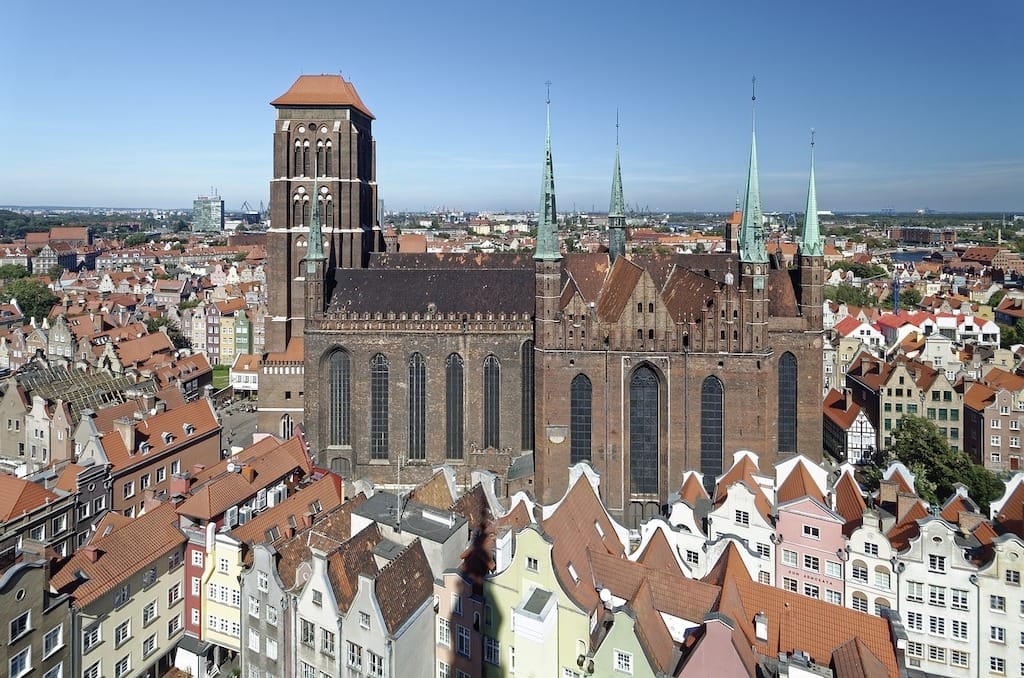
The Village Of Żuraw
The Zuraw is one of the most iconic attractions in Gdansk, and it should definitely feature on any walking tour of Old Town Gdansk.
The historic port crane dates back to the times when Gdansk was an important trading port. Although an earlier version reportedly existed in the 14th century, the current structure was built in the mid 15th century. It was the largest medieval crane in all of Europe.
The primary function of the huge crane was to transfer cargo on and off ships that came to the port and to remove and install masts on ships, but it also served as a gate for Old Town Gdansk. The two wooden wheels that work the crane were powered by humans walking the wheels!
The crane continued to be operational until the middle of the 19th century, but, like much else in Old Town Gdansk, was significantly damaged in World War II. After the war, it was painstakingly rebuilt, and today it is part of the Polish Maritime Museum. Inside, you will find exhibits relating to life in the port in days past.
The Zuraw is located on the bank of the Motlawa River and is visible at the far end of the waterfront walkway as you approach the Green Gate to Old Town Gdansk. Just walk Dlugie Pobrzeze, the waterfront street, from the Green Gate, and you will come right to the crane.
You can also view the crane from the opposite bank of the river, and take photos. It is lit up at night and looks beautiful.
Explored by Dhara from It’s Not About the Miles
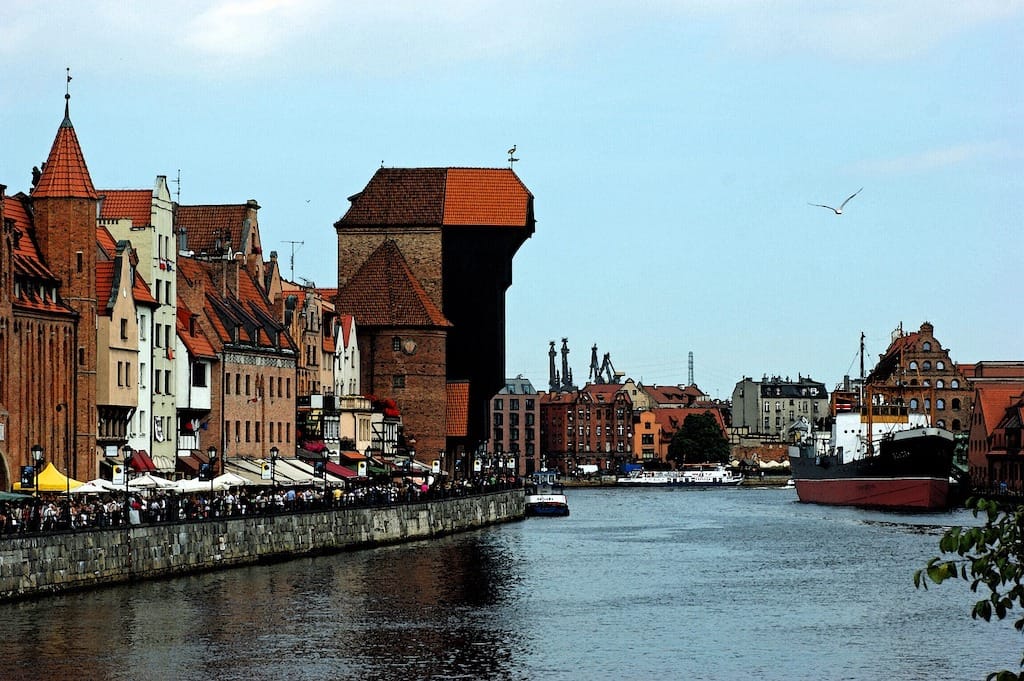
Wawel Castle
Wawel Castle is located at the southernmost point of Krakow’s historic Old Town, right on the northern bank of the Vistula River and a 10-minute walk from the Main Market Square. Perched on top of Wawel Hill overlooking the rest of the city, it is one of the most important historical sites in Poland and a very much recommended spot on any trip to Krakow.
Built-in the 13th century, the Castle was home to Polish kings and queens for generations before officially becoming the museum it is today in 1930. Over the century’s parts were burned down, rebuilt, and restored, with its blended Renaissance, Gothic and Baroque style making for the stunning building it is today.
Unsurprisingly, it can get very busy, especially in the summer months, however, booking in advance is a little tricky! The castle has five permanent exhibits; the State Rooms, the Royal Private Apartments, the Crown Treasury & Armoury, the Lost Wawel, and Oriental Art (alongside various temporary ones throughout the year). All require separate tickets with only the State Rooms available to be booked online easily.
For this reason, I recommend you get there when it opens so you don’t spend too long waiting in the ticket queues. Alternatively, you can just wander around the very attractive grounds for free (there are some beautiful views over the river). Plus, the grounds open from 6 am, well before everyone starts arriving to enter the castle, making it a quiet and peaceful opportunity to explore.
Along with the castle, you can also see the cathedral on the grounds or visit the crypt where royalty and people of national importance are laid to rest. If you come in the summer, you can descend into the caves at the foot of the hill into the Dragon’s Den (complete with fire breathing dragon, go see for yourself!) and then ascend Sandomierska Tower, one of the original watchtowers that were then converted into a residence for VIP prisoners.
Explored by Rachael from Champagne on Arrival
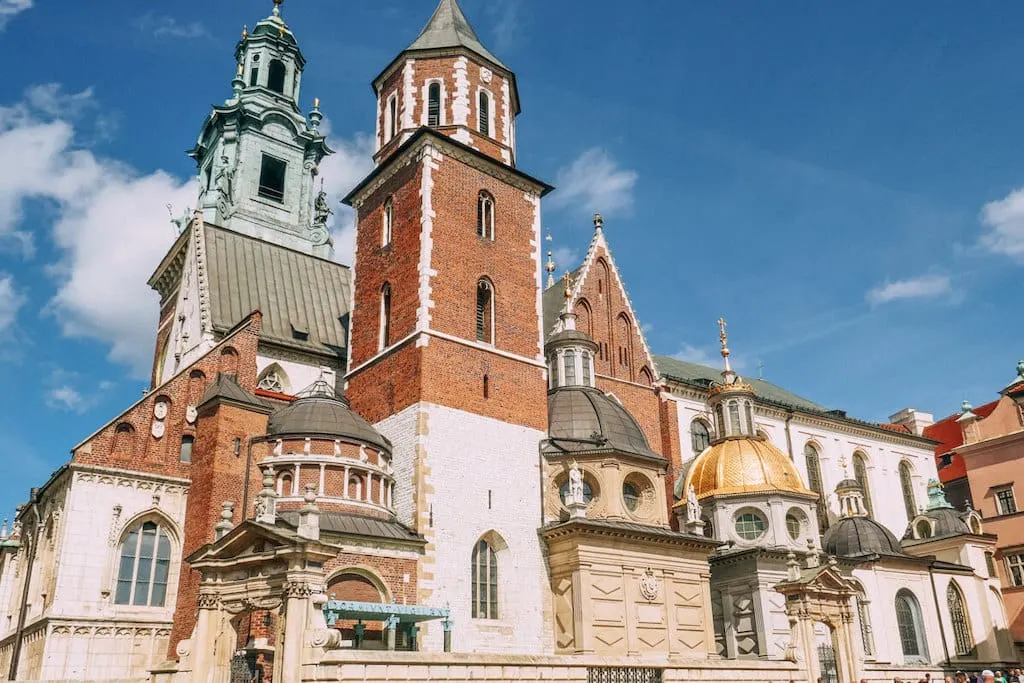
Wieliczka Salt Mine
There are numerous historic buildings and sites in Poland, but one that stands out is the Wieliczka Salt Mine. Located in the small town of Wieliczka, around 10km to the southeast of Krakow, the salt mine is a registered historic monument and an integral part of Poland’s history.
Excavations began in the mine in the 13th century, and salt was produced up until 2007 when mining was stopped. Today the salt mine is a popular tourist attraction where visitors can explore the numerous passageways and shafts of the mine, see an underground lake and even visit beautiful underground chambers, including the unique and stunning St Kinga’s Chapel. Visitors also get to learn about old mining tools, machines, the history of the mining town, and salt extraction techniques used in the past.
Getting to the salt mine is very easy with public transport. You can board one of the frequent bus or train services from Krakow or opt for the minivan services that depart from a stand near Krakow’s railway station. If you have hired a car, you can drive down in under half an hour from Krakow city center.
Prior booking is not essential to visit the salt mine but be prepared to set aside a day to explore it at a relaxed pace. There are a number of different routes to explore the mine (all guided tours), and whichever tour you go for, be prepared for a lot of walking (especially climbing down hundreds of stairs). I would recommend wearing comfortable shoes and carrying a warm jacket as it can get cold down in the mine.
Explored by Deeptha from The Globe Trotter
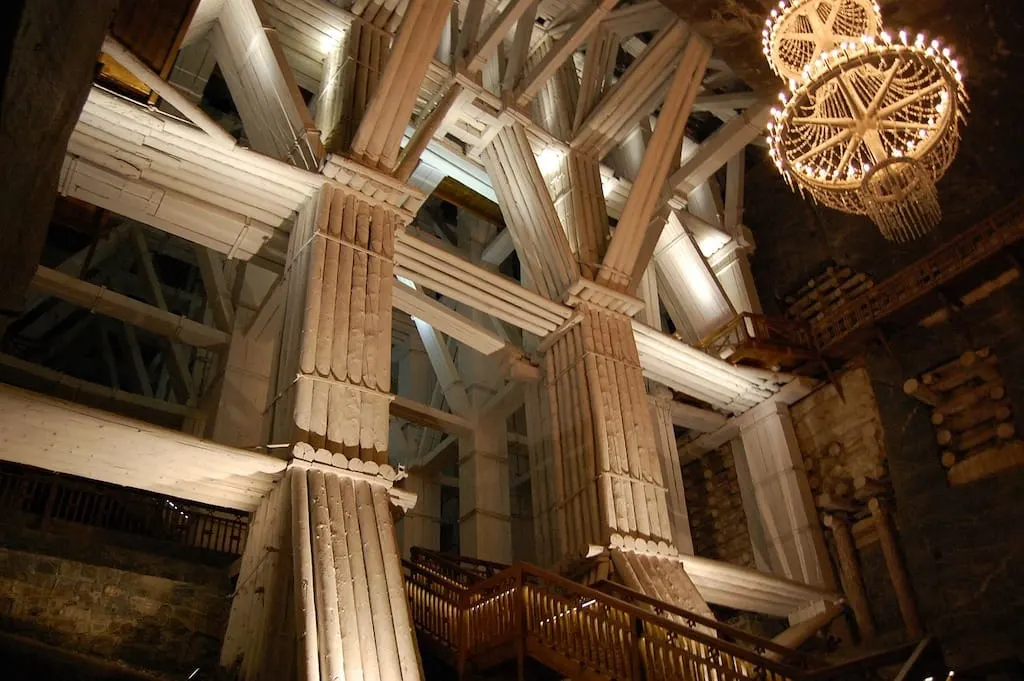
Wrocław Town Hall
Wroclaw Old City Hall, Stary Ratusz in Polish, belongs to the most admired sights in Wroclaw, Poland. You’ll understand why the minute you enter the Market Square in the heart of the Old Town. The large rectangular structure cannot be missed – it’s positioned right in the middle, and everything going on at the Square revolves around it.
The works on the Town Hall first started in the 13th century in the Gothic style – the iconic clock tower comes from that town and is believed to be the oldest one in Poland. The construction of the whole structure took another 250 years. The Old Town Hall part with the clock tower is located in its North, joined on the side by the New Town Hall, and a few government buildings and even residential houses.
The City Hall holds many treasures and stories. You cannot miss the strange-looking pillar in the front – it’s called a Pillory, and it was where criminals would be chained to and punished. Another treasure trove hides in the underground – the Piwnica Świdnicka, a pub from 1273. Beer was made and enjoyed here – even by the likes of Goethe, Chopin, or Picasso. The Piwnica is not open anymore, but you can still identify its entrance since it’s well marked.
You can see the insides of the Old City Hall on a visit to the City Museum of Wroclaw, which is housed there. Wroclaw Old Town is fully walkable and easy to get to on foot, even from the train station. You can also make use of the city trams.
Explored by Veronika Primm from Travel Geekery
